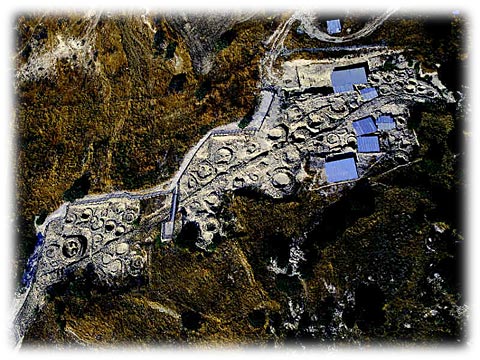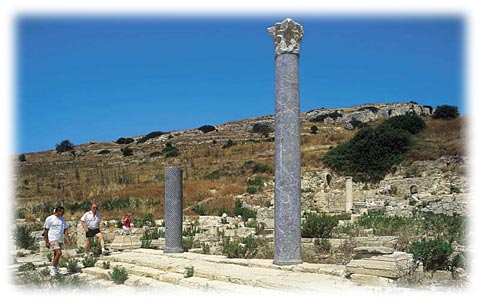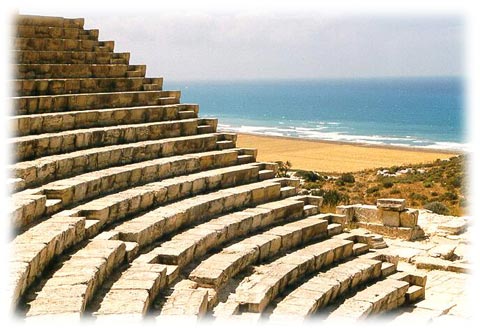|
With evidence of human habitation dating back around nine thousand years,
Cyprus is truly an island of rich and varied history.
Choirokoitia
- the earliest human settlement
The earliest signs of human habitation in Cyprus have been unearthed at Choirokoitia
near Larnaca and Cape Andreas in the Turkish Republic of North Cyprus.
The Neolithic settlement at Choirokoitia is an exceptionally well preserved example
of Neolithic life and continues to yield a wide range of information concerning
the spread of culture from the middle and near east to the european continent.
Choirokoitia appears to have been inhabited between the seventh and fourth millenium
B.C. and has proven of such great importance that it has been included in the
UNESCO world heritage preservation list.

Amathus
- one of the main Cyprus archaeological sites
The ruins of this ancient city kingdom, found a few miles to the east of Limassol,
date back at least three thousand years. The city itself took its name
from Amathusa, the mother of King Kinyras of Paphos.
Set on the high coastal cliffs and offering stunning views of the Mediterranean,
the city rapidly grew in importance and amassed great riches within a short
period after its founding. Around the 8th century B.C, a port was constructed
to aid trading between the Levantines and the Greeks.
Unsurprisingly, a temple dedicated to the worship of Aphrodite was also constructed
around the 1st century B.C.
Legends also proclaim Amathus to be the site of Adonia, a regular festival
in honour of the god Adonis.
With a rich and flourishing
agriculture and mining operations stretching as far afield as Kalavasos
to the east, Amathus was a prosperous city for many centuries.
During Roman times, the city was made the administrative centre of the region
and during the 4th century it was made the Episcopal See. Amathus continued
to prosper well into the Byzantine period.
The city's downfall came in 1191 A.D, when King Richard the Lionheart razed
Amathus to the ground and had much of the building stone moved to Limassol,
there to be used in new construction.

Kourion
- foremost of the ancient city kingdoms
By legend, this city was associated with Argos of Peloponnese. Its inhabitants
believed they were the decendants of Argean migrants who founded Kourion.
One of the main features of the city's ruins is a large temple, most likely
dedicated to the worship of Hera, the principal deity of Argos.
Like Amathus to the east, Kourion was built on the coastal cliffs, above
the fertile valley of the river Kouris.
Thus far, excavations at Kourion have yielded the monumental amphitheatre,
an early Christian basillica, a Nymphaeum, various 'Houses' featuring fabulous
mosaic work as well as the public baths of the city.
Somewhat to the west, the city's forum and the spectacular 'Sanctuary of
Apollo' have also been excavated.
A large monumental tomb, most likely belonging to king Stasanor and his
family was excavated in the necropolis during 1990 and 1991.

Continuing
excavations regularly unearth ruins and artifacts from the Hellenistic
and Roman eras.
Kourion was destroyed in a catastrophic earthquake in 365 A.D.
|
|
|
Archaeological sites of Cyprus
|
|
|
|
On
the northern outskirts of Paphos can be found the famous 'Tombs of the Kings',
a necropolis
intricately
carved from the bedrock. These tombs are hardly a new discovery, having been
known about and explored casually for the past few centuries. However, they
were first formally explored and catalogued in the 1970's and 1980's under
the guidance of Dr Sophocles Hadjisavvas, now Director of Antiquities of
the
Republic
of
Cyprus.
For more information about the 'Tombs
of the Kings', please click
here.
|
|
|
|
A few minutes walk to
the north east of the centre of Larnaca, you will come upon some of the
ruins of ancient Kition.
Little now remains of this important city kingdom, since Larnaca has been
built more or less on top of the original city.
The ruins themselves are of five temples, dating back to the 13th century
B.C.
Particularly noteworthy is the temple of Astarte, built on the site of an
older Bronze Age temple.
Part of the northern city walls, constructed of huge stones may also be seen
here.
To find more information about ancient
Kition, please click
here.
However, Cyprus' archaeological
sires are not the only thing drawing vast numbers of visitors to the Republic
each year.
The friendly, welcoming nature of the local population, the warm climate,
beautiful surroundings and fantastic beaches all contribute for shape an
island which is considered a firm favourite by many holiday makers and
prospective property buyers alike.
As mentioned on the previous
page, around twenty three percent of visitors to the island develop an
active interest in buying a property in Cyprus.
You would have to agree that this is an impressive figure indeed.
Presently, real estate
prices are still within reach of most prospective buyers.
Prices however, are steadily on the rise, with a projected growth of between
ten and twenty percent per annum.
Should you be interested
in buying a property in Cyprus, may we sugest that you visit Athina, a
truly invaluable source of unbiased information, designed to help you reach
an
informed, considered decision about your purchase.
Please click
here to
return to the previous page
|